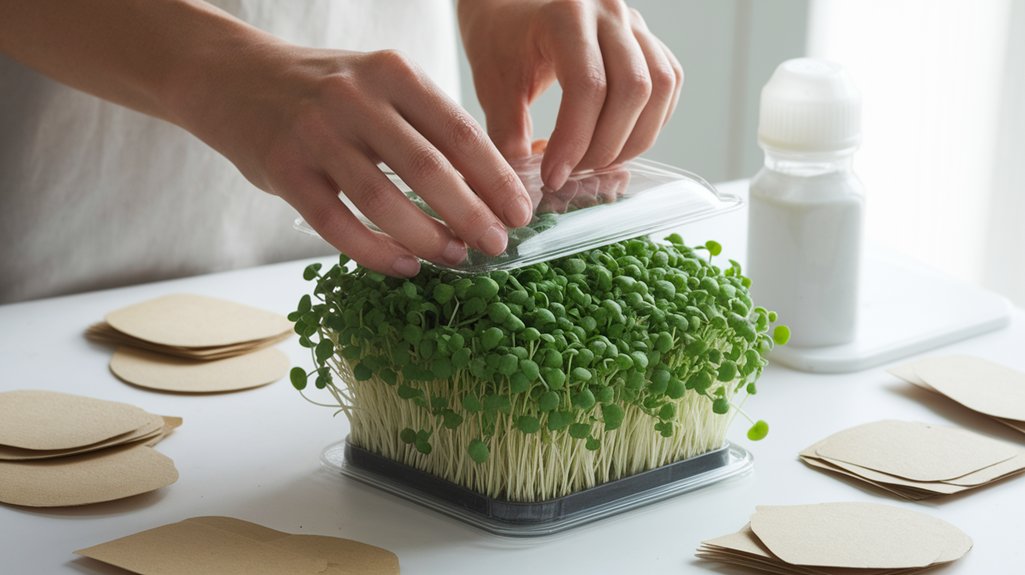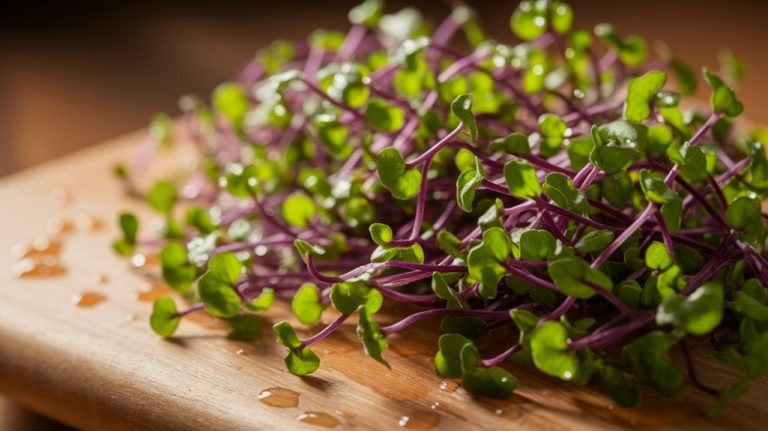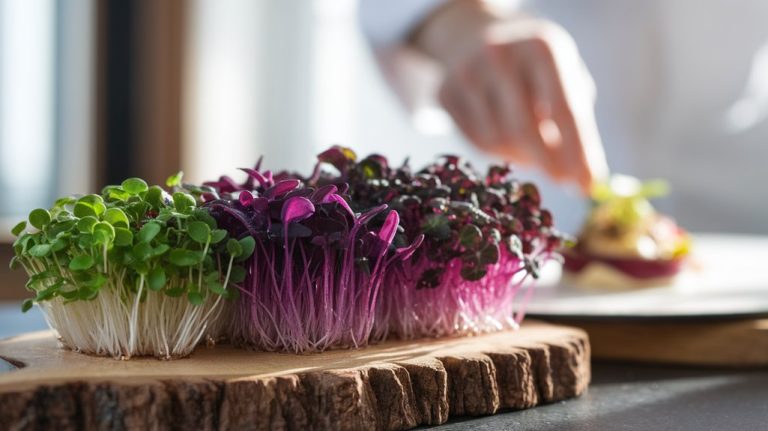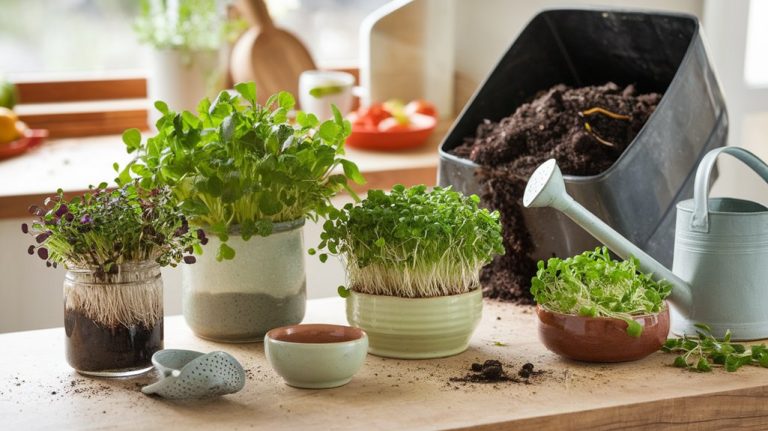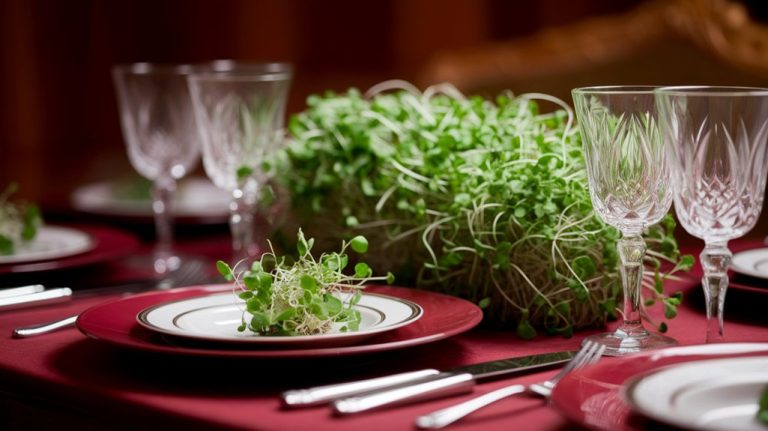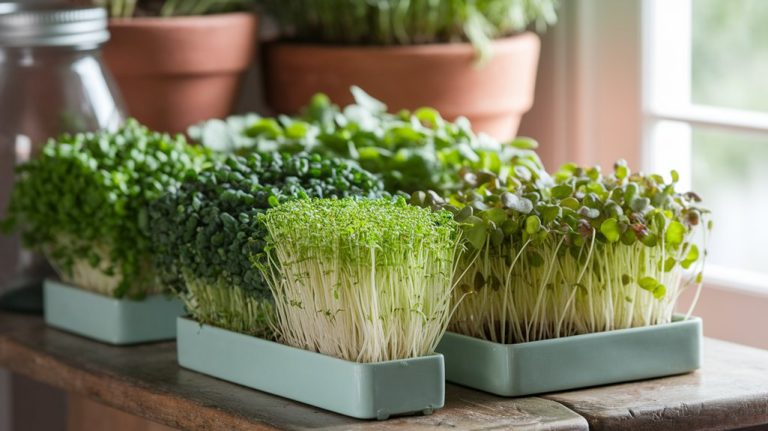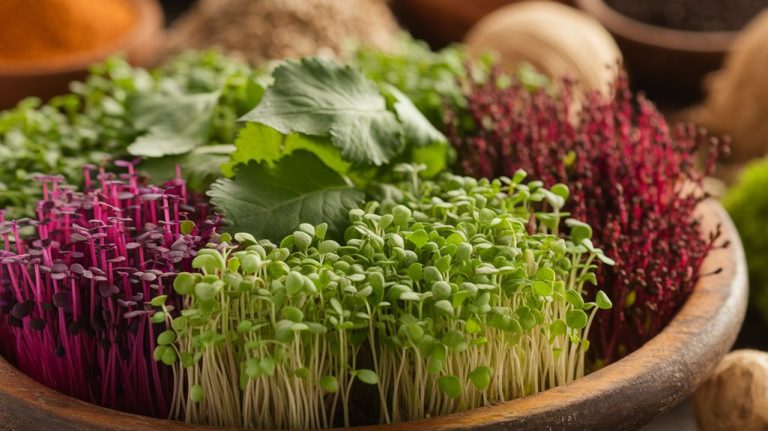Packaging Tips That Keep Microgreens Fresh for Markets
To keep microgreens fresh for markets, I focus on eco-friendly packaging materials like biodegradable containers and breathable bags. I ensure proper airflow with ventilated containers while controlling moisture with silica gel packets. Matching package sizes to customer preferences is key, as is prominently labeling for freshness and variety. During transport, I keep them cool using insulated packaging and ice packs. With these strategies, you can keep microgreens vibrant and appealing—there’s much more to explore in the process!
Key Takeaways
- Use breathable, ventilated containers to promote airflow and reduce moisture buildup, maintaining freshness during storage and transport.
- Choose biodegradable and compostable packaging materials to ensure eco-friendliness while preserving the quality of microgreens.
- Clearly label packages with the harvest date and variety name to inform customers about freshness and make identification easy.
- Avoid overcrowding microgreens in packaging to allow for proper airflow, preventing spoilage and ensuring optimal freshness.
- Incorporate moisture-absorbing materials like silica gel packets to control humidity levels and extend shelf life during transportation.
Choosing the Right Packaging Materials
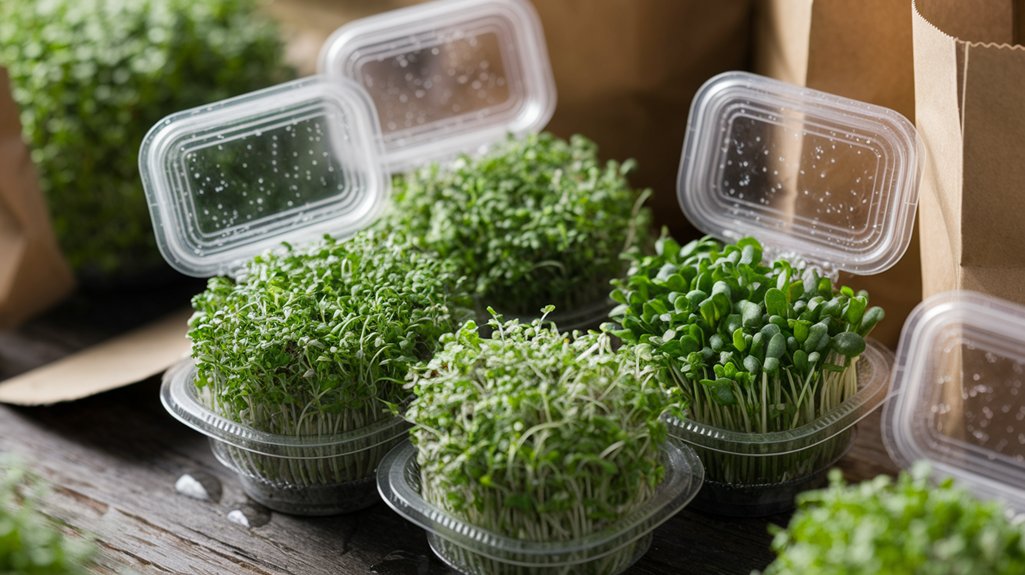
When I’m selecting packaging materials for microgreens, I always consider their freshness and shelf life. It’s crucial to choose materials that protect the delicate greens while allowing them to breathe.
I prefer using biodegradable options like plant-based containers or compostable bags, which are eco-friendly and maintain integrity. These materials reduce moisture buildup, preventing spoilage.
I also look for options that are lightweight yet sturdy, ensuring that the microgreens stay secure during transport. Clear packaging lets customers see the vibrant colors and freshness, making the product more appealing.
Ultimately, the right packaging not only preserves quality but also reflects my commitment to sustainability. Choosing wisely can make a significant difference in how my microgreens are received in the market.
Utilizing Ventilated Containers
When it comes to packaging microgreens, I can’t stress enough the importance of airflow.
Choosing the right ventilated containers not only helps maintain freshness but also impacts the overall quality of your greens.
Let’s explore the key factors like material selection and the optimal size and shape for these containers.
Importance of Airflow
Although it might seem minor, airflow is crucial for keeping microgreens fresh and vibrant. When I package my greens, I always choose ventilated containers to promote circulation. This helps prevent moisture buildup and keeps the microgreens from wilting or molding.
Here’s a quick overview of airflow benefits:
| Benefit | Description |
|---|---|
| Reduces moisture | Less risk of mold growth |
| Maintains crunchiness | Keeps leaves crisp and appetizing |
| Extends shelf life | Freshness lasts longer in storage |
| Enhances flavor | Helps preserve the delicate taste |
| Encourages growth | Supports healthy, robust microgreens |
Material Selection Considerations
Choosing the right materials for packaging microgreens is essential, especially if you want to maintain their freshness and quality.
One effective option I’ve found is using ventilated containers, which allow for proper airflow and help prevent moisture buildup.
Here are some key considerations when selecting materials:
- Breathability: Choose containers with adequate ventilation holes.
- Durability: Opt for sturdy materials that can withstand handling.
- Recyclability: Look for eco-friendly options to appeal to environmentally conscious customers.
- Visibility: Clear containers let customers see the vibrant greens inside.
- Size Compatibility: Ensure the container fits your microgreens without crushing them.
Size and Shape Factors
After considering the materials for packaging microgreens, it’s important to think about the size and shape of your containers. I’ve found that using ventilated containers is crucial for maintaining freshness. These containers allow for proper airflow, which helps prevent moisture buildup and mold growth.
When choosing the size, consider how much product you’re selling; smaller containers are perfect for individual servings, while larger ones work for bulk sales.
Opt for shallow containers, as they minimize pressure on the delicate greens. I also recommend square or rectangular shapes, which maximize space in transport and display.
Incorporating Moisture Control Techniques
When I package microgreens, I always prioritize moisture control to ensure they stay fresh and vibrant for longer. Proper moisture management not only extends shelf life but also enhances the quality of the greens.
Here are some techniques I use:
- Use breathable packaging to allow moisture to escape.
- Incorporate moisture-absorbing materials, like silica gel packets, to keep humidity levels in check.
- Avoid washing microgreens before packaging; excess water can lead to spoilage.
- Store in cool environments to slow down moisture buildup and decay.
- Seal packages tightly to prevent external humidity from affecting the microgreens.
Selecting Appropriate Sizes for Packaging
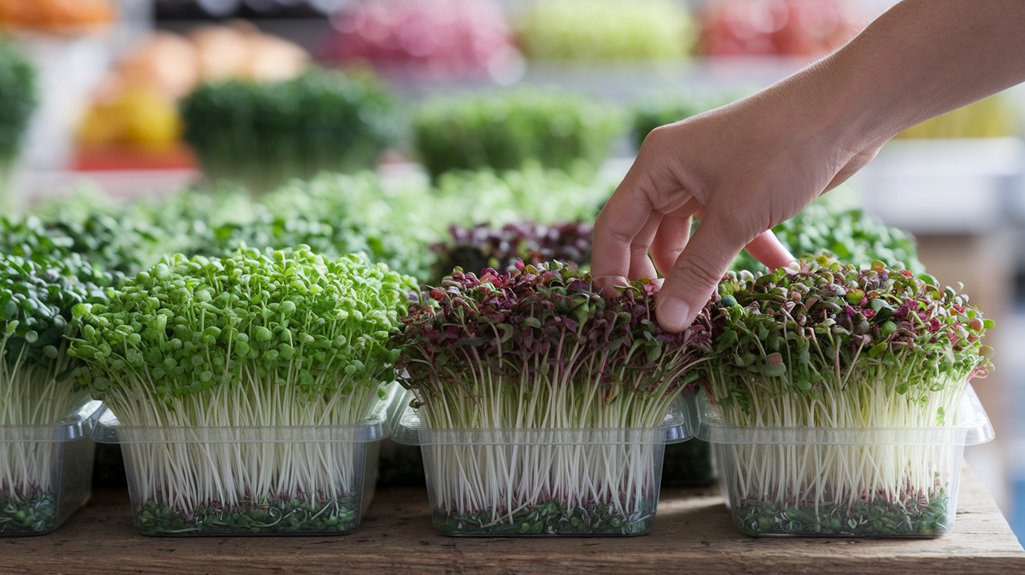
When selecting the right sizes for packaging microgreens, I always consider the volume requirements and how much space they’ll take up on the shelf.
It’s essential to think about the customer’s needs while also choosing sustainable materials that reflect our commitment to the environment.
Balancing these factors ensures that my microgreens not only look great but also sell well.
Consider Volume Requirements
Choosing the right packaging size for microgreens is crucial for both freshness and presentation. It’s essential to consider the volume requirements that match your customers’ needs.
I’ve found that selecting the appropriate sizes can significantly impact sales and reduce waste. Here are some tips to keep in mind:
- Match portion sizes: Offer small, medium, and large options to cater to different customer preferences.
- Avoid overcrowding: Ensure there’s enough space for airflow to maintain freshness.
- Consider the market: Tailor sizes based on whether you’re selling to restaurants or at farmers’ markets.
- Think about storage: Choose sizes that fit easily into your clients’ fridge spaces.
- Test your packaging: Experiment with different sizes to find the perfect fit for your microgreens.
Assess Shelf Space Needs
While assessing shelf space needs, I find it essential to consider how your packaging will fit into various retail environments. You’ll want to analyze the dimensions of the shelves where your microgreens will be displayed. Are they tall and narrow, or wide and flat?
It’s crucial to choose packaging sizes that maximize visibility and accessibility. I often opt for smaller containers for tighter spaces, allowing customers to easily grab and go. Additionally, think about stacking options; packaging that can be easily stacked saves space and enhances organization.
Finally, keep in mind the overall aesthetic—your packaging should stand out without overwhelming the display. By carefully evaluating these factors, you can ensure your microgreens attract attention while staying fresh.
Choose Sustainable Materials
As I explore sustainable materials for packaging microgreens, I realize how vital it’s to balance eco-friendliness with functionality.
Choosing the right size and type of packaging not only preserves freshness but also supports environmental efforts. Here are some materials I’m considering:
- Biodegradable plastics – break down naturally, reducing landfill impact.
- Recycled paper – lightweight and compostable, perfect for smaller batches.
- Glass containers – reusable and recyclable, providing a sleek presentation.
- Plant-based fabrics – breathable, allowing moisture control while being sustainable.
- Cardboard boxes – easy to source and biodegradable, ideal for bulk packaging.
Labeling for Freshness and Appeal
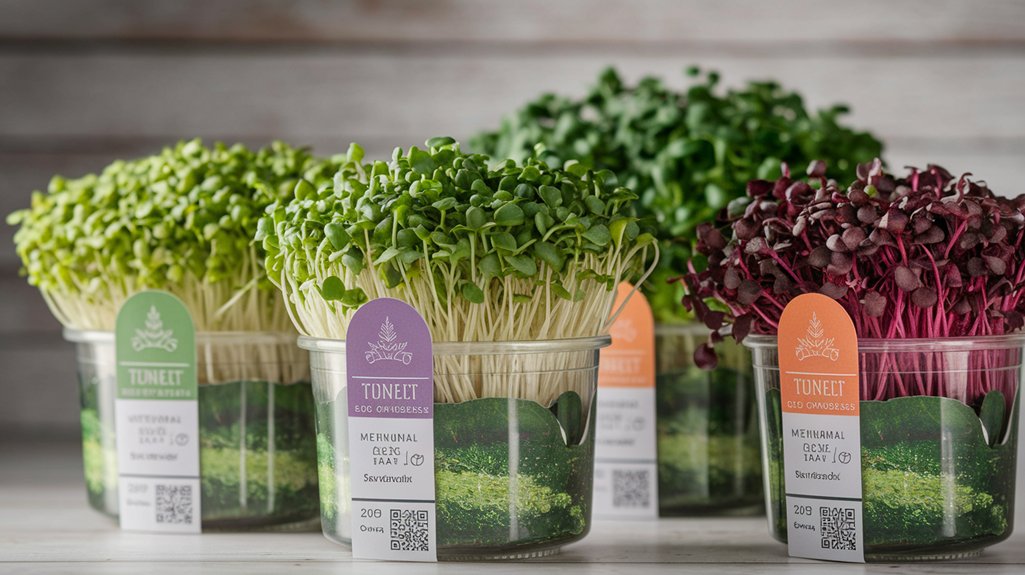
When I think about the importance of labeling for microgreens, I realize that a well-designed label can significantly enhance both freshness and visual appeal. A great label not only communicates essential information but also draws customers in. Here are some key elements to consider:
| Element | Description |
|---|---|
| Freshness Date | Clearly state the harvest date to ensure customers know when the product is at its best. |
| Variety Name | Make sure the type of microgreen is prominently displayed for easy identification. |
| Nutritional Info | Include quick nutritional benefits to entice health-conscious buyers. |
| Storage Instructions | Provide tips on how to keep microgreens fresh longer. |
Using Eco-Friendly Packaging Solutions
Choosing the right packaging for microgreens goes beyond just aesthetics; it also involves making environmentally conscious decisions.
I’ve found that using eco-friendly materials not only appeals to customers but also helps reduce our ecological footprint.
Here are some great options I recommend:
- Biodegradable containers: They break down naturally, leaving no waste behind.
- Recycled paper wraps: Stylish and sustainable, they’re perfect for smaller bunches.
- Compostable bags: These keep microgreens fresh while being friendly to the planet.
- Glass jars: Reusable and recyclable, they offer a chic presentation.
- Plant-based films: They provide moisture control without harming the environment.
Keeping Microgreens Cool During Transport
When transporting microgreens, keeping them cool is crucial for maintaining their freshness.
I’ve found that using insulated packaging and considering the duration of transport can make a big difference.
Let’s explore some effective temperature control methods to ensure your microgreens arrive in top condition.
Temperature Control Methods
While transporting microgreens, maintaining their freshness is crucial, and effective temperature control methods can make all the difference.
Here are some practical tips that I’ve found helpful:
- Use chilled containers to keep the greens cool.
- Incorporate ice packs to absorb heat during transport.
- Avoid direct sunlight exposure; cover the microgreens with a light cloth.
- Monitor the temperature regularly with a thermometer.
- Limit transport time to reduce heat buildup.
Insulated Packaging Solutions
To ensure your microgreens stay fresh during transport, insulated packaging solutions are essential. I’ve found that using insulated boxes or bags can significantly help maintain a cool temperature, which is crucial for preserving the quality of your greens.
Look for packaging that features thick walls and reflective materials, as these can minimize temperature changes.
Additionally, I recommend incorporating gel packs or ice packs, especially for longer journeys. Just be careful to prevent excess moisture, as it can lead to spoilage.
Always seal your packages tightly to maintain the internal environment. By investing in proper insulated packaging, you’ll not only keep your microgreens fresh but also enhance your reputation at markets and with customers.
Trust me, it’s worth the effort!
Transport Duration Considerations
As I’ve learned through experience, the length of transport plays a crucial role in keeping microgreens cool and fresh. If I’m not careful, the stress of heat can diminish their quality.
Here are some practical tips I follow to maintain freshness during transport:
- Use ice packs: Place them strategically around the microgreens to keep them cool.
- Minimize exposure: Keep the packaging sealed until it’s time to distribute.
- Choose the right vehicle: Use a van or truck with air conditioning when possible.
- Plan your route: Optimize your delivery path to shorten transport time.
- Check temperatures: Monitor the internal temperature regularly to ensure it stays low.
Displaying Microgreens for Maximum Visibility
When I showcase microgreens, I always aim to create a display that draws the eye and piques interest. I use clear containers to highlight the vibrant colors and textures of the greens, ensuring they stand out. Arranging them in an appealing, organized manner helps customers quickly see their options.
I also incorporate height variations by using tiered stands, which adds depth to the display. Adding small signs with names and benefits of each microgreen encourages engagement and education. To enhance visibility, I place the display in a well-lit area, allowing natural light to further accentuate the freshness.
Lastly, I keep the area tidy and replenished, ensuring everything looks inviting and fresh at all times.
Sealing Techniques to Preserve Freshness
While I want my microgreens to look great on display, sealing techniques are crucial for maintaining their freshness once they leave the stand. Proper sealing can make all the difference, ensuring my customers receive the best possible product.
Here are some effective techniques I use:
- Use breathable bags: They allow moisture to escape while keeping greens fresh.
- Vacuum sealing: This removes air, slowing down spoilage.
- Use moisture absorbers: Silica gel packets can help control humidity levels.
- Seal with clips: Simple yet effective, clips can keep bags tightly closed.
- Label clearly: Provide a clear date to inform customers of freshness.
Educating Customers on Microgreen Care
Microgreens are delicate wonders that require a bit of care to thrive once they reach your kitchen. I always recommend giving them a gentle rinse under cool water and patting them dry with a paper towel.
Storing them in a breathable container in the fridge is key; it keeps them fresh longer. If you notice any wilting, a quick soak in cold water can revive them beautifully.
When it comes to usage, I love adding them to salads, sandwiches, or as garnishes. Just remember, they’re best enjoyed fresh!
Educating customers about these simple steps not only helps them enjoy their microgreens but also enhances their overall experience with your product.
Happy growing!
Frequently Asked Questions
How Long Can Microgreens Stay Fresh in Packaging?
I’ve found that microgreens can stay fresh for about 7 to 14 days when properly packaged.
It really depends on the type and storage conditions. I always keep them in a cool, dark place, and I make sure the packaging allows some airflow.
If you spot any moisture, it’s best to use a paper towel to absorb it. Trust me, keeping them dry helps extend their shelf life significantly!
What Types of Microgreens Require Special Packaging Considerations?
When it comes to microgreens, I’ve found that delicate varieties like pea shoots and arugula really need special packaging. Their tender leaves bruise easily, so I always opt for breathable containers that provide ventilation.
I also consider moisture control; using paper towels can absorb excess moisture, preventing wilting.
For heartier greens like radish microgreens, I don’t worry as much, but I still ensure they’re snug and protected during transport.
Can I Reuse Packaging for Microgreens?
Absolutely, you can reuse packaging for microgreens, but it’s essential to ensure it’s clean and free from contaminants.
I often rinse out containers and let them dry completely before reusing. This not only saves money but also reduces waste.
Just remember to check for any signs of wear or damage, as that can affect the freshness of your microgreens.
Keeping them safe and fresh is my top priority!
What Is the Best Way to Transport Microgreens for Farmers’ Markets?
When I transport my microgreens to farmers’ markets, I always use sturdy, breathable containers that allow airflow.
I prefer clamshells or perforated bags to keep them fresh and protected. I pack them tightly but not squished, ensuring they stay upright during transit.
I also place a damp paper towel in the container to maintain humidity. This method keeps my microgreens vibrant and appealing, ready to impress customers when I set up my stall.
How Do I Remove Moisture Without Damaging Microgreens?
I’ve found that removing moisture from microgreens without damaging them is a delicate process. I gently pat them dry with a soft cloth or use a salad spinner, ensuring I handle them lightly.
If I need to dehydrate them further, I use a fan set on low, directing air across them. This way, I maintain their crispness while preventing any bruising.
It’s all about being gentle and patient to preserve their freshness!
Conclusion
Incorporating these packaging tips can really make a difference in keeping your microgreens fresh and appealing for your customers. By choosing the right materials, controlling moisture, and ensuring proper labeling, you’ll not only enhance their shelf life but also attract more buyers. Remember, a little effort in packaging goes a long way in showcasing the quality of your microgreens. So, let’s keep those greens vibrant and delicious, making every market day a success!

